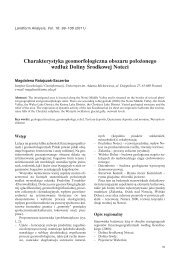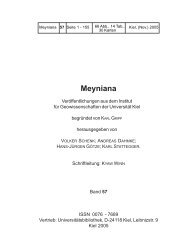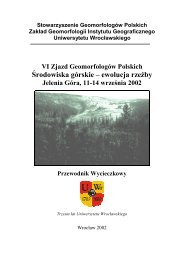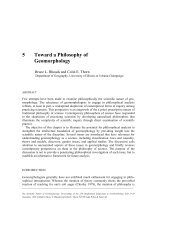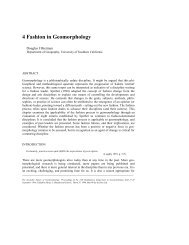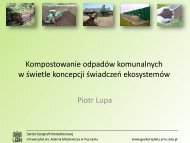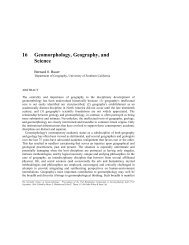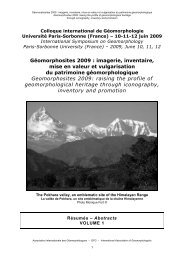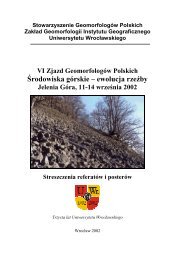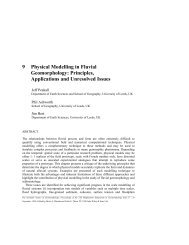Chapter 16 - Geomorphology, Geography, and Science Bernard 0
Chapter 16 - Geomorphology, Geography, and Science Bernard 0
Chapter 16 - Geomorphology, Geography, and Science Bernard 0
Create successful ePaper yourself
Turn your PDF publications into a flip-book with our unique Google optimized e-Paper software.
382 SCIENTIFIC NATURE OF GEOMORPHOLOGY<br />
in: (1) an increasing number of subspecializations in geomorphology beyond the<br />
traditional cores; (2) an increasing number of methodological <strong>and</strong> philosophical<br />
perspectives being brought to bear on geomorphic problems; (3) an increasing concern<br />
with the integrity of geomorphological claims to knowledge, especially those that assume<br />
scientific postures; <strong>and</strong> (4) an increasing appreciation for the necessity of utilitarian<br />
research, especially in the face of inexorable alteration of earth's surface by the profound<br />
activity of humans, <strong>and</strong> for the express purpose of ensuring disciplinary survival by<br />
demonstrating contemporary relevance. In these contexts, geography serves to inform <strong>and</strong><br />
heighten geomorphology's awareness of the physical, intellectual, <strong>and</strong> social pulses of the<br />
world around us.<br />
OBJECTIVES AND CAVEATS<br />
The original objective of this chapter was to provide an evaluation <strong>and</strong> elucidation of 'the<br />
ways in which geographic theory <strong>and</strong> methods have influenced or are currently<br />
influencing the development of geomorphology as a science' (Rhoads <strong>and</strong> Thorn, personal<br />
communication). Such an undertaking turns out to be unrealistic for several reasons. First,<br />
it accepts, a priori, the existence of theories <strong>and</strong> methods that are distinctly geographical,<br />
their readily identifiable character, their acceptance <strong>and</strong> use by the geographic community,<br />
<strong>and</strong> their transplantation into the geomorphological corpus. Many have taken exception to<br />
such assertions, <strong>and</strong> Schaefer (1953, p. 227), for one, contends that the '. . . existence of a<br />
field ... needs no "methodological" justification'. Yatsu (1992, p. 92) concurs <strong>and</strong> suggests<br />
that 'for the development of scientific knowledge, researchers must use any method<br />
available'. Although certain disciplines might easily be characterized on the basis of<br />
distinctive theories <strong>and</strong> methods (e.g. mathematics or engineering), this is neither a<br />
necessary nor sufficient condition. <strong>Geography</strong>, in particular, encompasses a broad<br />
spectrum of theories <strong>and</strong> methods, many of which have evolved in association with<br />
developments in other disciplines, <strong>and</strong> thus, the donor-recipient relationships are not<br />
evident.<br />
Second, it implicitly assumes that there is widespread agreement as to the meaning <strong>and</strong><br />
implications of 'science', that geomorphology is considered to be a science by the broader<br />
community of academics, <strong>and</strong> that we, as geomorphologists, find it desirable for<br />
geomorphology to be(come) scientific. These issues are at the very core of<br />
geomorphology, <strong>and</strong> one need only scan the recent geomorphological <strong>and</strong> geographical<br />
literature to get a sense of the prevailing confusion <strong>and</strong> ambiguity surrounding them (e.g.<br />
Richards 1990, 1994; Baker <strong>and</strong> Twidale 1991; Yatsu 1992; Rhoads <strong>and</strong> Thorn 1993,<br />
1994; Bassett 1994; Rhoads 1994). Ontological <strong>and</strong> epistemological concerns are central<br />
to these debates but are ordinarily the domain of the philosopher or historian of science.<br />
Are geomorphologists prepared to engage these debates or will they reach, once again, for<br />
the soil auger (cf. Chorley 1978)?<br />
Third, it is inherently confrontational because it is tantamount to geographical representation<br />
in the 'Championship of the Disciplines' (i.e. disciplines most influential to the<br />
development of geomorphology). In such endeavors it is often convenient <strong>and</strong> effective to<br />
place in opposition the merits of one discipline against those of another. Supporting<br />
arguments <strong>and</strong> expositions are often based on extremist, opinionated, historically super-



